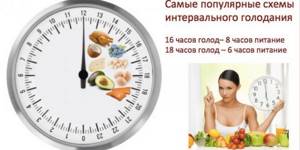It so happened that it was the term “intermittent fasting” that took root among the majority of adherents of this method. Although “interval nutrition” sounds much softer, it carries the same meaning.
This nutrition system can be the most comfortable way for you to lose weight and, most importantly, maintain your ideal weight without much difficulty. So don’t let the word “fasting” scare you, it doesn’t mean at all that you need to starve yourself to death.
In this article, I will share my personal experience of intermittent fasting for weight loss, give examples of different IF regimens, and also tell you how to correctly apply this method to beginners.
What is intermittent fasting
What is intermittent fasting? The principle of this system, which gets its name from the English term Intermittent fasting, is based on the periodic refusal of all food. What is the point of diet? The nutrition system suggests periodically giving up all food. The duration of abstinence from food is 6, 8, 16 or 20 hours. Due to this system, the body becomes insensitive to carbohydrates, including those with a high glycemic index.
Among foods high in carbohydrates, when losing weight, you should avoid white rice, semolina, sweets, boiled potatoes and beans.
But why does weight come off when such a program is practiced? During inactive hours, appetite is suppressed and you only want to eat at the “right” hours. At the same time, during a pause in food intake, the body is actively engaged in burning its own fat deposits. The stomach is empty and resting during these hours. Due to this, it is reduced in volume. Accordingly, if you don’t eat a lot, the number of all servings decreases, the total calorie content of the diet decreases, which becomes the basis for weight loss.
Photo source: shutterstock.com
Is it really possible to lose weight on an intermittent diet? If yes, then for how long? This is true! Within the framework of such a nutrition system, which is not similar to therapeutic or separate, you can lose up to 5 kg in 3 days.
General Tips
Regardless of the chosen scheme, to increase efficiency it is necessary to follow a number of simple rules:
- Accounting for caloric intake. For any type of fasting, the amount of calories consumed per day should not be higher than recommended. To calculate, you can use the following formulas: men = 88.36 + (13.4 x weight, kg) + (4.8 x height, cm) – (5.7 x age, years); women = 447.6 + (9.2 x weight, kg) + (3.1 x height, cm) – (4.3 x age, years).
- Drinking enough water. You should never limit your water intake. Avoid dry fasting techniques.
- Cheer yourself up. If you are extremely hungry, you need to try to improve your mood and distract yourself (going to the cinema, walking in the park, etc.).
- Emphasis on saturation. You should eat foods that are low in calories, but cause a quick feeling of fullness in the stomach (raw vegetables and fruits, grapes, melon, popcorn).
- Use of spices. They will give any dish a more pleasant taste and better satisfy your hunger. Perfect for: spices, vinegar, herbs and garlic in any form.
- Maintaining a balanced diet. The human body must receive sufficient amounts of vitamins, macro- and microelements, and fiber to maintain its vital functions. A balanced diet is the basis of a healthy lifestyle!
Following simple rules of fasting can increase the benefits and reduce the risk of side effects and complications caused by a poor diet.
Rules and principles of intermittent fasting
To lose weight with intermittent fasting, you need to understand its essence and main rules. If you want to lose weight by a few kilograms by adhering to this program, you need to carry out such an interval diet correctly. It is enough to adhere to the following rules:
- the entire daily amount of calories must be placed in the windows allocated for food;
- You can eat a lot, but you can’t overeat;
- meals are divided: these are 3-4 main meals with fruit, nut or vegetable snacks;
- You need to completely give up all semi-finished products, fast food, baked goods, flour baked goods, as well as simple carbohydrates, which constantly make you want to eat.
It is important to exclude packaged nectars and juices from stores from the menu, since most of these drinks contain a lot of sugar.

Photo source: shutterstock.com
Often, an interval diet takes place in such a way that a person remains in the usual morning hours without breakfast. But this diet implies the first meal as the most calorie-dense and dense. It’s good if it includes easily digestible animal fats and complex carbohydrates. All other meals should be protein, which means you will have to make a schedule in advance and calculate the amount of fats, proteins and carbohydrates in each amount of food.
Another rule of such intensive interval weight loss is to adhere to the drinking regime. Don't forget to drink plenty of fluids during these days. There is an instruction for all followers of the hunger strike: you need to drink a lot of water. Minimum - 2 liters per day. Another strategy allows you to use lemon water, unsweetened green tea and celery juice, which have almost no carbohydrates.
How long can you eat according to this plan at 18/6 hours? As many as you like - the number of days is not limited. The first week will be quite difficult, but you need to wait out the hungry “waves”. This usually goes away after a month.
Success largely depends on how you get into the routine. To lose weight properly, you need to start a fast correctly. You should not immediately practice long-term abstinence from food - one-day fasting does not immediately help. Keep the fast for a shorter time at first, optimally 12 hours.
Intermittent fasting and training
It is unlikely that you will be able to achieve high-quality results and noticeable weight loss using partial fasting if you give up physical activity. This type of 6/18 diet works effectively when combined with exercise. This can be any activity:
- morning exercises at home from 7 minutes a day;
- fitness;
- jogging;
- dancing;
- swimming;
- cycling, etc.
But integral fasting works best if you do high-intensity training during the diet. For men this could be boxing, and for women it could be cardio. There are other effective options, but it is recommended to discuss them with a trainer, especially in the early stages of weight loss.

Photo source: shutterstock.com
If an athlete practices intermittent fasting, then it is recommended to schedule all workouts 2 hours before the eating window begins. All exercises must be performed on an empty stomach. If the classes are very active, then it is allowed to consume the amino acid in the amount of 1 tbsp. l. With such a nutritional system, this substance is necessary for the normal process of building muscle mass.
Intermittent fasting and alcohol
Almost all diets exclude alcohol. But cyclic fasting makes it easier. Occasionally you can allow yourself a little wine drink on such a diet, and sometimes dry white wine during dinner.

Photo source: shutterstock.com
But when including alcohol in your diet, you need to take into account the amount of carbohydrates they contain. The ideal solution for intermittent fasting is dry wines. For 1 glass they contain from 0.5 to 1 g of carbohydrates. In sweet wines for the same amount there are already from 4 to 6 g. There are no carbohydrates at all in vodka, tequila, gin, cognac, whiskey. Therefore, with such a diet, almost all strong alcohol without carbohydrates is acceptable. But it must be consumed with diet soda or drunk neat.
When losing weight, keep in mind: there are a lot of carbohydrates in Madeira, punch, liqueur, and sherry.
Breaking out of intermittent fasting
You need to leave the fast very carefully. The longer a woman has been on this diet, the more careful she should be after finishing it so that the weight does not return. Avoid overeating at first. Avoid large portions and anything new in your diet. For internal comfort, you need to eat right, keeping track of the number of calories. You can use a special application for this.
ABC RECOMMENDS

Weight loss rules for a girl who lost more than half her weight
Stage two - meat

The purpose of this stage is to provide the body with the necessary amount of calories without converting them into fat deposits. To achieve this goal, animal protein is used. It allows you to quickly and effectively satisfy hunger, saturate the body, build muscles, renew cells, and maintain the required fluid level. Protein takes a long time to digest and requires a lot of energy. Since protein days imply the absence of carbohydrates in the diet, energy for digesting food will be drawn from fat reserves.
Basics of nutrition in the second stage:
- You can eat fish and meat boiled or baked. No breading or butter should be used;
- One day's menu should not include both fish and meat;
- At the second stage, do not forget to consume fiber or bran along with protein foods to maintain normal digestion.
Permitted products in the second stage:
- Chicken breast, turkey, rabbit, lean beef and fish - up to 900 g. in a day;
- Low-fat cottage cheese – 200 gr. in a day;
- Lemon or lime juice as a dressing or seasoning;
- Fiber, bran – 1-3 small spoons per day;
- Spices, spices;
- Egg whites – up to four pieces per day;
- Greenery;
- Fermented milk drinks 0% fat – a couple of glasses a day;
- Unsweetened green tea.
Menu for the second stage
- In the morning, you can prepare a protein omelet, seasoned with herbs, and drink a glass of yoghurt with bran.
- Between breakfast and lunch, you can make a snack of cottage cheese with the addition of greens and a cup of green tea.
- For lunch, bake meat and drink a cup of green tea.
- For an afternoon snack, eat another portion of meat, some greens and drink a glass of kefir with bran.
- In the evening, cook some meat and drink green tea.
If you cannot cope with hunger before bed, then satisfy it with a couple of spoons of bran.
Intermittent fasting: benefits and harms
Like any diet, intermittent fasting has its pros and cons. What is the benefit of this diet with a 16/8 clock division? This nutritional system has a positive effect on the body because:
- fat burning is achieved through the consumption of all fats stored by the body;
- weight loss occurs due to the expenditure of the entire amount of lipid reserves and a calorie deficit;
- The synthesis of hormones is accelerated, as the intercellular processes occurring in the organs are activated. Insulin levels drop and fat begins to burn;
- many substances are produced that are responsible for cellular regeneration and muscle building.
Among other positive properties of such a fast, there is a risk of developing type 2 diabetes. Resistance to stress increases, sleep becomes stronger. Your well-being improves, and your movements become easier. Digestion and blood pressure are normalized. Efficiency and energy levels increase.

Photo source: shutterstock.com
This system also helps accelerate metabolism by up to 14%. It is especially effective in reducing weight in the abdominal and waist areas. For women, this nutritional method is also useful because the quality of the hair becomes better and the nails become stronger. Acne disappears, the skin becomes fresher and smoother, and rejuvenation is observed. Another advantage of the technique is the preservation of muscle mass while losing weight overall, which is why athletes often practice fasting.
The main advantage of the system is long-term storage of results.
But like any other diet, intermittent fasting has its downsides. Who can the food system harm? Possible negative consequences of the system are worth noting:
- burping;
- dizziness;
- constipation and other digestive system disorders;
- stomach discomfort;
- headaches and migraines, which are a consequence of stress;
- heartburn.
Among all the negative manifestations of the diet, irregularities in the menstrual cycle in girls and muscle spasms are noted. But the last drawback can be corrected by increasing the amount of protein in food.
Advantages
Before you start fasting, you should consult a specialist. It will help eliminate possible contraindications and clarify the conditions for fasting. If you prepare carefully, you can appreciate the numerous advantages of the system:
- No need to count calories. Unlike the Dukan diet and other similar weight loss methods, fasting does not require weighing each portion. Figure correction occurs by burning internal fat deposits.
- Full saturation. Each meal during intermittent fasting ensures a feeling of fullness. Knowing that a meal will provide pleasure and energy, a hunger strike is much easier to bear.
- Active fat burning. During fasting, adipose tissue is burned and the process of autophagy is launched - self-absorption of damaged, dead, diseased cells occurs. They are being replaced by new structures. As a result, a person loses weight and literally becomes younger before our eyes.
After prolonged fasting, other changes in the body are also expected:
- Improved mood.
- Increased performance and mental abilities.
- Excellent cosmetic effect.
- Improved metabolism and regeneration.
- Normalization of blood pressure.
- Reduced blood sugar levels.
Intermittent fasting 16/8 for weight loss: scheme
The sample diet plan is simple. It will allow you to lose weight comfortably, so that a woman can see her results, but without stress. There are many example circuits, here is one of them:
- 8:00 - 1 glass of filtered water;
- 9:00 - 1 glass of unsweetened green tea;
- 11:00 - a cup of coffee or tea;
- 12:00 - 1 tsp. amino acids for athletes;
- 12:00-13:00 – training;
- 13:00 - breakfast;
- 17:00 - lunch;
- 20:30 - dinner.
From 21:00 to 13:00 there is a hunger strike. In this case, breakfast should make up from 40 to 50% of the total daily energy value. Lunch covers 35% of the total calories, and dinner - 25%. All intervals can be adjusted to suit your regime.
ABC RECOMMENDS

What do Russian ballerinas eat to always stay slim?
Intermittent fasting menu 16/8
A 5-day menu during intermittent fasting may look like this:
| Day | Breakfast | Dinner | Dinner |
| 1 | Steamed rice with boiled flounder, a slice of marshmallow, coffee with milk and 1 bran bread | Couscous with boiled chicken breast, mixed vegetables, berry juice | A glass of 1% kefir and a steam omelette of 3 proteins |
| 2 | Bread, oatmeal with dried fruits and a slice of butter, coffee with 1 marshmallow | Tomato juice, fresh vegetable juice, fresh vegetable salad | Baked tuna piece with cherry tomatoes and grilled sweet peppers |
| 3 | Curd casserole with sour cream, 20 g dark chocolate, tea with honey | Steamed chicken cutlets with fresh pomegranate juice and roasted sweet pepper salad | A couple of boiled eggs, cottage cheese casserole with a glass of milk |
| 4 | Vegetable salad with sour cream, spaghetti with boiled sea bass, casinak, bread and coffee with milk | Boiled chicken breast, cream cheese soup, milk tea, tomato and cucumber salad with sour cream | Beef baked with vegetables |
| 5 | Cheesecakes with honey and cocoa with marshmallows | Steamed fish, mushroom soup, fruit smoothie and sweet pepper and cabbage salad | Boiled shrimp and steamed salmon steaks |
Breakfast should contain many calories, and dinner should be light and protein-rich. Lunch during intermittent fasting should be as balanced as possible. You should strictly consider the ratio of KBZHU and the content of the total amount of necessary nutrients.
The intermittent fasting menu can be adjusted to suit your taste and habits. You can take not 3, but all 4 meals. Also, with such a nutrition system, the introduction of snacks is allowed. But not a lot, and they should be nuts or vegetables.
Stage three – vegetable

During this period you need to eat vegetables. It is advisable to consume them raw. They are rich in fiber, which will restore normal functioning of the digestive tract after heavy meat days.
Nutrition basics in the third stage:
- Vegetables can be eaten raw, boiled, baked;
- Beets and carrots can only be eaten raw;
- Vegetables can be seasoned with a small amount of vegetable oil, which improves the absorption of some important vitamins;
- Portions should be small. You can't overeat these days.
Permitted products in the third stage:
- Cucumbers;
- Zucchini;
- Carrot;
- Beet;
- Green beans;
- Cabbage;
- Fermented milk drinks 0% fat – up to two glasses a day;
- Vegetable oil – up to two large spoons per day;
- Spices, seasonings;
- Tomatoes;
- Onion;
- Spinach;
- Celery;
- Bulgarian pepper;
- Mushrooms;
- Unsweetened green tea;
- Grape and apple cider vinegar in small quantities as a dressing.
Menu for the third stage
- In the morning you can prepare a tomato-cucumber salad with the addition of herbs, seasoned with a small spoon of vegetable oil. You can also drink a glass of kefir.
- The first snack will be celery salad with bell pepper, seasoned with a small spoon of vegetable oil, and green tea.
- Have lunch with stewed cabbage and mushrooms. Do not add oil!
- The second snack is cabbage and carrot salad with vinegar dressing.
- The evening meal will consist of boiled broccoli and a glass of 0% fat yogurt.
- Before going to bed, you can drink a glass of 0% fat kefir and a couple of spoons of bran.
Contraindications for intermittent fasting
This weight loss regimen is not suitable for everyone. For some people, the food system can only bring harm. Therefore, before choosing, you should take into account all contraindications.

Photo source: shutterstock.com
There are many of them, so you should not practice intermittent fasting if:
- diabetes type 1 and 2;
- thyrotoxicosis and other diseases of the thyroid gland;
- cold;
- influenza and feverish conditions;
- pregnancy, breastfeeding and babywearing;
- under 18 years of age;
- underweight.
Intermittent fasting can harm people with high acidity of gastric juice, mental health disorders, cardiovascular failure of 2 and 3 degrees, myocarditis, ischemia, thrombophlebitis and other pathologies of the cardiovascular system. It is worth abandoning this experiment with nutrition during pregnancy, after surgery and during lactation, with gastritis, pancreatitis and hypothyroidism. It is forbidden to practice intermittent fasting for weight loss if you have gout and many stomach diseases.
12 hour fast
The rules of this diet are simple. A person should adhere to a 12-hour fast every day. According to some researchers, fasting for 10 to 16 hours forces the body to convert stored fat into energy, which releases ketones into the bloodstream. This should help you lose weight.
This type of intermittent fasting can be a good option for beginners because most fasting occurs while you sleep. The easiest way is to include a 12-hour fast during your sleep period. For example, a person might choose to fast between 7 pm and 7 am. He must finish his dinner before 7 pm and wait until 7 am to have breakfast.
Intermittent fasting 16/8: reviews and results
The results of this program are simply amazing. In just 3 days you can get rid of up to 5 extra kg. It is not fiction that up to 2 kg are lost in 24 hours. However, usually the results are more modest. The main thing is the long-lasting effect, which is often indicated in reviews by those who have practiced the system.
Galina : “Feeling better, weight has returned to normal, fat loss has disappeared.”
Elena : “There is an effect, you can eat whatever you want and lose weight.”
Intermittent fasting: before and after photos
Using “Before” and “After” photos you can evaluate how effective a cyclic nutrition system is for weight loss.
Nutritional patterns for the resonance diet

With a cyclical diet, the day is divided into two periods, displayed in numbers, which are indicated through a fraction: the eating window and fasting. The effectiveness of different regimes differs in the degree of complexity and speed of weight loss. Gentle fasting every other day, when fasting consists of consuming about 500 calories, is a very simple method to quickly and easily get your body in shape.
There are more strict interval feeding schemes that are not suitable for everyone, but only for people in good health who do not have chronic diseases. A cyclic diet is selected according to initial body weight, gender, age, physical activity and other individual factors.
Easy Intermittent Fasting 12/12
This cyclical diet scheme is suitable for beginners or people who adhere to fractional meals. This intermittent diet can be followed, if necessary, for the rest of one’s life. A day consisting of 24 hours is divided in half. 12 hours are allotted for eating, and a similar time for fasting. There is also a more complicated version of cyclic nutrition - 14/10. The periodic diet is easy to follow - at least 12 or 14 hours should pass between dinner and breakfast.
16 hour fast

This is a complex interval feeding scheme - the eating window is only 8 hours, the rest of the day abstains from food. During the phase when you can eat, you are allowed to consume any food and the prescribed number of calories. Effective 16/8 intermittent fasting guarantees rapid weight loss with minimal energy expenditure.
This cyclical diet scheme is suitable for long-term adherence (3-4 weeks) for both men and women, including those who play sports. The optimal scheme of interval nutrition, in which the body “dries” occurs.
The effectiveness of an intermittent diet can be easily increased if you exclude processed foods and other harmful foods from your diet.
Diet for 3 days according to the 20/4 scheme
This type of interval eating means that the eating window is only 4 hours, the remaining 20 are the period of hunger. The founder of this spartan eating regimen is the artist Ori Hofmekler. A strict three-day diet for weight loss allows you to get rid of 500-700 grams of excess weight per day, and with physical activity - up to 1 kg.
During the fasting phase, it is allowed, in addition to water, tea or coffee, to drink fresh vegetable or fruit juices. You can snack on nuts; after training, you can drink a glass of kefir, yogurt, or eat 2 hard-boiled chicken eggs. During the four-hour eating window, you are allowed to consume everything except junk foods. The main thing is to follow the order: first fiber, then proteins and fats, then carbohydrates.
Intermittent fasting mode 2/5
The cyclical diet from Michael Mosley involves consuming a limited number of calories over two days: for men - 600 kcal in 24 hours, for women - 500 kcal. The remaining five days are the usual diet with a standard calorie intake corresponding to gender, body weight, lifestyle, and body characteristics. This intermittent feeding regimen is suitable for long-term use until the desired body weight is reached (approximately 1 to 3 months).











